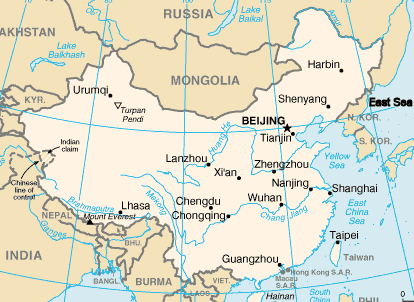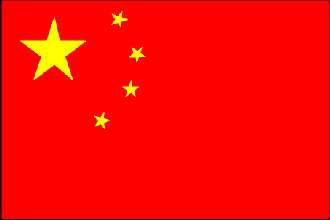
|

People's Republic of China
Background:
For centuries China has stood as a leading civilization, outpacing
the rest of the world in the arts and sciences. But in the first half of the
20th century, China was beset by major famines, civil unrest, military defeats,
and foreign occupation. After World War II, the Communists under Mao Zedong
established a dictatorship that, while ensuring China's sovereignty, imposed
strict controls over everyday life and cost the lives of tens of millions of
people. After 1978, his successor Deng Xiaoping gradually introduced
market-oriented reforms and decentralized economic decision making. Output
quadrupled in the next 20 years and China now has the world's second largest
GDP. Political controls remain tight even while economic controls continue to
weaken.
Location:
Area: land: 9,326,410 sq km, water: 270,550 sq km.
Area - comparative: Slightly smaller than the US.
Land boundaries: Total: 22,147.24 km, border countries: Afghanistan 76 km,
Bhutan 470 km, Burma 2,185 km, Hong Kong 30 km, India 3,380 km, Kazakhstan
1,533 km, North Korea 1,416 km, Kyrgyz Stan 858 km, Laos 423 km, Macao 0.34 km,
Mongolia 4,676.9 km, Nepal 1,236 km, Pakistan 523 km, Russia (northeast) 3,605
km, Russia (northwest) 40 km, Tajikistan 414 km, Vietnam 1,281 km.
Coastline: 14,500 km.
|
|
Climate and Terrain:
Extremely diverse; tropical in south to subarctic in north.
Mostly mountains, high plateaus, deserts in west; plains, deltas, and
hills in east.
Elevation extremes: Lowest point: Turpan Pendi -154 m, highest point: Mount
Everest 8,850 m.
People:
Population: 1,273,111,290.
Ethnic groups: Han Chinese 91.9%, other 8.1% .
Religions: Daoist, Buddhist, Muslim 2%-3%, Christian 1%.
note: officially atheist.
Government:
Government type: Communist state.
Capital: Beijing.
Administrative divisions: 23 provinces, 5 autonomous regions* and 4
municipalities.
Economy overview:
In late 1978 the Chinese leadership began moving the
economy from a sluggish Soviet-style centrally planned economy to a more
market-oriented system. The authorities have
switched to a system of household responsibility in agriculture in place of the
old collectivization, increased the authority of local officials and plant
managers in industry, permitted a wide variety of small-scale enterprise in
services and light manufacturing, and opened the economy to increased foreign
trade and investment. The result has been a quadrupling of GDP since 1978. In
2000, with its 1.26 billion people but a GDP of just $3,600 per capita, China
stood as the second largest economy in the world after the US.
Labor force - by occupation: Agriculture 50%, industry 24%, services 26%.
Return to Visiting Locations
|

